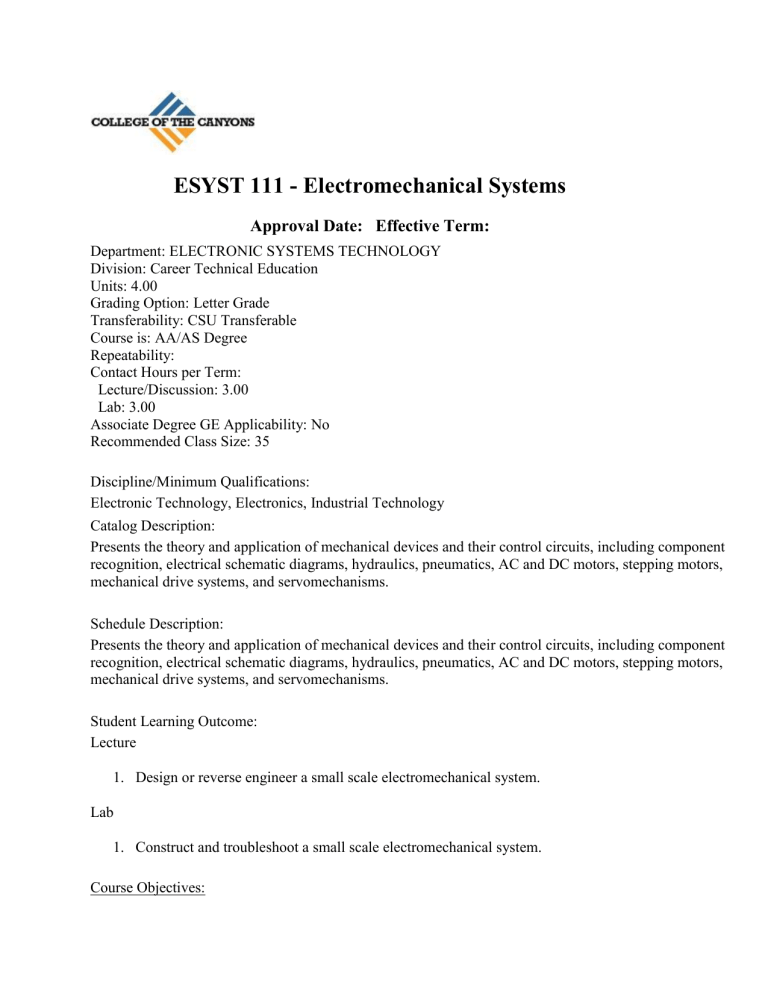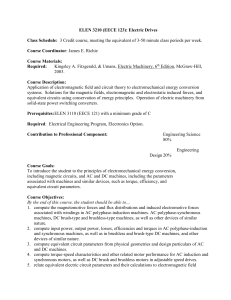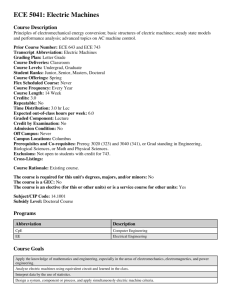ESYST 111 - Electromechanical Systems

ESYST 111 - Electromechanical Systems
Approval Date: Effective Term:
Department: ELECTRONIC SYSTEMS TECHNOLOGY
Division: Career Technical Education
Units: 4.00
Grading Option: Letter Grade
Transferability: CSU Transferable
Course is: AA/AS Degree
Repeatability:
Contact Hours per Term:
Lecture/Discussion: 3.00
Lab: 3.00
Associate Degree GE Applicability: No
Recommended Class Size: 35
Discipline/Minimum Qualifications:
Electronic Technology, Electronics, Industrial Technology
Catalog Description:
Presents the theory and application of mechanical devices and their control circuits, including component recognition, electrical schematic diagrams, hydraulics, pneumatics, AC and DC motors, stepping motors, mechanical drive systems, and servomechanisms.
Schedule Description:
Presents the theory and application of mechanical devices and their control circuits, including component recognition, electrical schematic diagrams, hydraulics, pneumatics, AC and DC motors, stepping motors, mechanical drive systems, and servomechanisms.
Student Learning Outcome:
Lecture
1.
Design or reverse engineer a small scale electromechanical system.
Lab
1.
Construct and troubleshoot a small scale electromechanical system.
Course Objectives:
Lecture
1.
Evaluate the various applications of mechanical devices and their control circuits.
2.
Evaluate applicable maintenance procedures and troubleshooting techniques for a given electromechanical system.
3.
Define terms associated with motors, motor control servo systems, fluid power systems, pneumatic power systems, and mechanical drives.
4.
Design a stepper motor control system.
5.
Design a fluid power system.
6.
Design a pneumatic power system.
Lab
1.
Work safely around and with industrial equipment.
2.
Identify and use basic hand and mechanical tool sets of the electromechanical industry.
3.
Interpret a diagram, assemble and disassemble systems and subsystems to perform maintenance, troubleshoot, and repair.
4.
Construct a stepper motor control system.
5.
Construct a fluid power system.
6.
Construct a pneumatic power system.
Course Content Outline:
Lecture
1.
Electromechanical terminology and definitions.
2.
Electromechanical system, subsystem and component identification.
1.
PCB - Printed Circuit Board
2.
Controllers
3.
Component Connectors
3.
Electromechanical hand and power tool sets.
1.
Multimeters
2.
Oscilloscopes
3.
Pressure Indicators
4.
Power Supplies.
4.
Relays, Contactors, and Motor Starters.
1.
Overload Relays.
2.
The Control Transformer.
3.
Timing Relays.
4.
Pressure Switches and Sensors.
5.
Float Switches.
6.
Flow Switches and Sensors.
7.
Limit Switches.
8.
Phase Failure Relays.
9.
Solenoid and Motor Operated Valves.
5.
Sensors
1.
Temperature Sensing Devices.
2.
Force, Torque, and Tactile Sensors.
3.
Hall Effect Sensors.
4.
Proximity Detectors.
5.
Photodetectors.
6.
Motor theory (AC and DC).
1.
Solid-State DC Drives.
2.
Stepping Motors.
3.
The Motor and Starting Methods.
4.
Resistor and Reactor Starting for AC Motors.
5.
Autotransformer Starting.
6.
Wye-Delta Starting.
7.
Part Winding Starters.
8.
Consequent Pole Motors.
9.
Variable Voltage and Magnetic Clutches.
10.
Braking.
11.
Wound Rotor Induction Motors.
12.
Synchronous Motors.
13.
Variable Frequency Control.
7.
Motor Installation.
1.
Positioning transducers.
2.
Mechanical drives.
8.
Fluid power systems.
1.
Fluid power components.
2.
Electronic and electrical controls of fluid power systems.
9.
Pneumatic power systems.
1.
Pneumatic power components.
2.
Electronic and electrical controls of pneumatic power systems.
10.
Electronic board schematics.
11.
Electronic test equipme nt.
1.
Handheld.
2.
Powered
12.
Equipment maintenance.
1.
Preventive Maintenance.
13.
Equipment troubleshooting.
1.
Measures of System Performance.
2.
Devices for Data Conversion.
3.
Transducers and Signal Conditioning.
Lab
1.
Using basic hand and mechanical tool sets of the electromechanical industry.
2.
Demonstrating basic safety techniques around electricity and industrial equipment.
3.
Reading a manufacturers manual and included schematics.
4.
Operating and maintaining a functioning electromechanical system.
Methods of Instruction:
Lab , Lecture:
Methods of Evaluation:
Exams/Tests/Quizzes
Problem Solving
Skill Demonstrations
Exams
Typical Assignments:
Reading:
Technical specifications for electromechanical systems Schematics for electronic circuits Text Readings
Writing, Problem Solving or Performance:
Design a fluid power system. Construct a fluid power system.
Other:
Required Materials Examples:
Book 1
Author: James R. Daines Publication Date: 2009
Title:Fluid Power: Hydraulics and Pneumatics Publisher: Goodheart-Wilcox
Book 2
Author: Stephen Herman
Title:Industrial Motor Control
Publication Date: 2010
Publisher: Delmar Cengage Learning
Book 3
Author: Devdas Shetty, Richard A. Kolk Publication Date: 2011
Title:Mechatronics System Design Publisher: Delmar Cengage Learning
Course Preparation:
Prerequisite(s):
Co-Requisite(s):
None
ESYST 101
CMPELC 130
Edition: 1st
Edition: 6th
Edition: 2nd
Recommended: None




